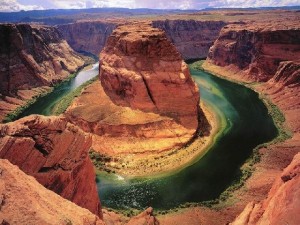Conventional wisdom has it that the Grand Canyon was carved out by the Colorado some 6-7 million years ago. Now, new chemical studies of the helium spectra of Canyon rock are calling that wisdom into question claiming that the canyon is over 60 million years old. From Science News:
But the new study, reported online November 29 in Science, looks instead at the chemistry of rocks exposed throughout the canyon. Rocks get cooler as erosion strips away the material above them. That cooling is chemically preserved in several ways, including in helium within the mineral apatite.
“When the apatite is hot, the helium simply diffuses out of the crystal; when the apatite is cold, helium is completely retained,” says study leader Rebecca Flowers of the University of Colorado Boulder. “So by measuring the helium we are constraining when the rock went from hot to cold as it moved closer to the Earth’s surface, or as the Earth’s surface moved closer to the rock as the canyon was carved.”
Flowers and Kenneth Farley of Caltech looked at helium in apatite crystals throughout the canyon, including how the element was distributed within the crystals — which gives more clues as to whether the rock cooled slowly or quickly. The scientists concluded that some ancient river must have carved out a chasm roughly the shape and size of the Grand Canyon by around 70 million years ago.
Not everyone is convinced by the new findings, which build on earlier work from the same research team. Karl Karlstrom, a geologist at the University of New Mexico, says that there must have been canyons throughout the area 70 million years ago, but most geological evidence supports the modern canyon — what visitors see today when standing at the rim — appearing only in the last 5 million to 6 million years.
Also check the New York Times and Science for more.

